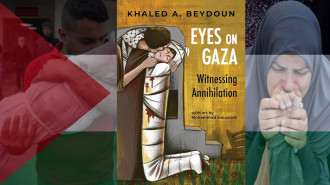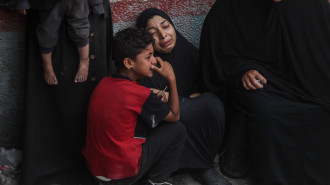

The fight for the land is also a struggle to uphold an identity and way of life in Palestine.
The link between society and the environment is strong, with the olive tree symbolising Palestinian resilience and rootedness.
This is why Bethlehem’s Museum for Natural History showcases endangered species, Palestinian culture, and ethnography.
Mazin Qumsiyeh started the project in 2014, and the museum opened to the public in 2017.
“We’re celebrating our 10th anniversary, but this is a lifelong process,” the director tells The New Arab proudly.
Located on a hill close to the Separation Wall running through the town, the museum offers a space of relief and preservation: a community garden, a botanic garden, fishponds, a farm with chickens, rabbits, and doves, as well as two greenhouses using hydroponics and aquaponics. An animal rehabilitation unit even hosted two hyenas, a rare sight.
The New Arab was welcomed by Jessie Qumsiyeh, Mazin’s wife and co-founder, and taken for a tour through the gardens while the evening sun started its descent, projecting golden rays of light through the olive trees, gardenias, and herb bushes.
Inside, the museum brims with fossils, stuffed animals, and information panels about Palestine’s environment and heritage. At first glance, the visitor may feel overwhelmed before delving into a treasure chest of information.
“We work to protect endangered ecosystems, to collect plants here in case they go extinct, but also to educate the Palestinian public and provide community services, because we can’t protect nature without people,” Qumsiyeh explained.
“It is important to maintain our way of growing our own food sustainably like our grandparents used. Our vision is to foster sustainable human and natural communities through conservation, research, education, and community service,” he added.
“Everything in the exhibits is also associated with research we’ve done on ethnography, mammals, plants, and the agricultural heritage of this region, which is the Fertile Crescent, the birthplace of agriculture,” Qumsiyeh explained.
Environmental harm in Gaza
One element on display catches the eye: tear gas canisters that Qumsiyeh and his wife gathered after demonstrations.
Conflict is, sadly, at the heart of Qumsiyeh’s project. He founded the Palestine Institute for Biodiversity and Sustainability at Bethlehem University partly to address the effects of conflict and colonization on the environment.
Ever since, this research institute has been “bridging gaps in science, policy, and practice. This should be done by ministries, but our corrupt Palestinian Authority under the Oslo Agreements only fulfils the protection of the occupation,” Qumsiyeh added.
“The major threats faced by Palestine are climate change, habitat destruction, pollution, invasive species, conflicts, and wars,” he explained.
The New Arab interviewed Mazin in his office, where he was working on his laptop. PowerPoint presentations on the war, press articles, and graphs made it look more like the desk of an anti-war activist than that of an abstraction-loving academic.
“My last research paper was on the effect of the recent war on Gaza on nature, from army training to bombing and unexploded ordnance,” he explained.
“In the first two months of the war on the people of Gaza, Israeli military jets alone produced more greenhouse gases than the Central African Republic produced in a whole year from all sources,” he added, quoting a Guardian report.
“Wadi Gaza, a nature reserve, is now largely destroyed, including by the new Israeli road dividing Gaza into northern and southern halves, isolating them from one another.
"Gaza’s soil will be contaminated for decades by nitrates and other pollutants. Without speaking of the environmental impact of massive displacement and communicable diseases which one million Gazans suffer from,” he explained.
Ecocide in historical Palestine
The environmental destruction caused by Israel in Gaza is part of a long-term and systematic destruction of the Palestinian environment, which Qumsiyeh believes should be called an ecocide.
“Israel is one of the most destructive countries for the environment: it uprooted far more trees than it reforested, then it planted European pine trees instead of endemic kinds, causing huge wildfires.
"Israeli colonisers destroyed entire ecosystems such as the Hula Lake and wetlands (219 species disappeared) and diverted and dried up the Jordan River basin,” he explained.
For Qumsiyeh, ethnic cleansing and ecocide go hand-in-hand, “like in all colonial systems,” he added.
“The indigenous community of Palestinians, who lived here for thousands of years, were related to their environment and co-adapted with it – animals, plants, and humans’ biology grew together,” he said.
“But colonial powers have to reshape the country to their image. Destroying local ecosystems ensures the destruction of the people who are part of it. And Israel did exactly that, by imposing European plants and ways of living: large farms, pine trees, enclosed communities.
"But what’s different with Zionism is that they plan to reshape the country according to the Bible and the Torah,” Qumsiyeh added.
“Many species went extinct, like the fishing owl from the Zarqa River, leopards, and cheetahs – some before the creation of Israel – and many are on the brink, like the Hubara bird in the Negev and many birds of prey,” he sighed.
For the researcher, one known example of a similar process happened during the European colonisation of the Americas.
“Europeans killed 150 million indigenous people, possibly the largest genocide in human history – but they also killed 2-3 million buffalo to destroy the Great Plains indigenous ecosystems, devastating the environments and plants.”
This, in turn, leads to a bleak outlook for Palestine.
“European colonisers devastated the environment, whether in the Americas or Palestine, because they want to reshape the landscape without the indigenous people – and any remnant natives will be stored in reservations,” he said.
As the sun set over the gardens and greenhouses, and the last visitors headed home, an atmosphere of nostalgia and sadness pervaded the air.
In the distance, Israeli settlements surrounded Bethlehem with roads, walls, and fences.
The museum felt like the community garden of a large open-air prison – a quest to keep memories, plants, and animals alive despite the onslaught of violence and dispossession.
But it also felt like an oasis of hope and life in the middle of destruction.
Philippe Pernot is a French-German photojournalist living in Beirut. Covering anarchist, environmentalist, and queer social movements, he is now the Lebanon correspondent for Frankfurter Rundschau and an editor for various international media
Follow him on Twitter: @PhilippePernot7






 Follow the Middle East's top stories in English at The New Arab on Google News
Follow the Middle East's top stories in English at The New Arab on Google News


